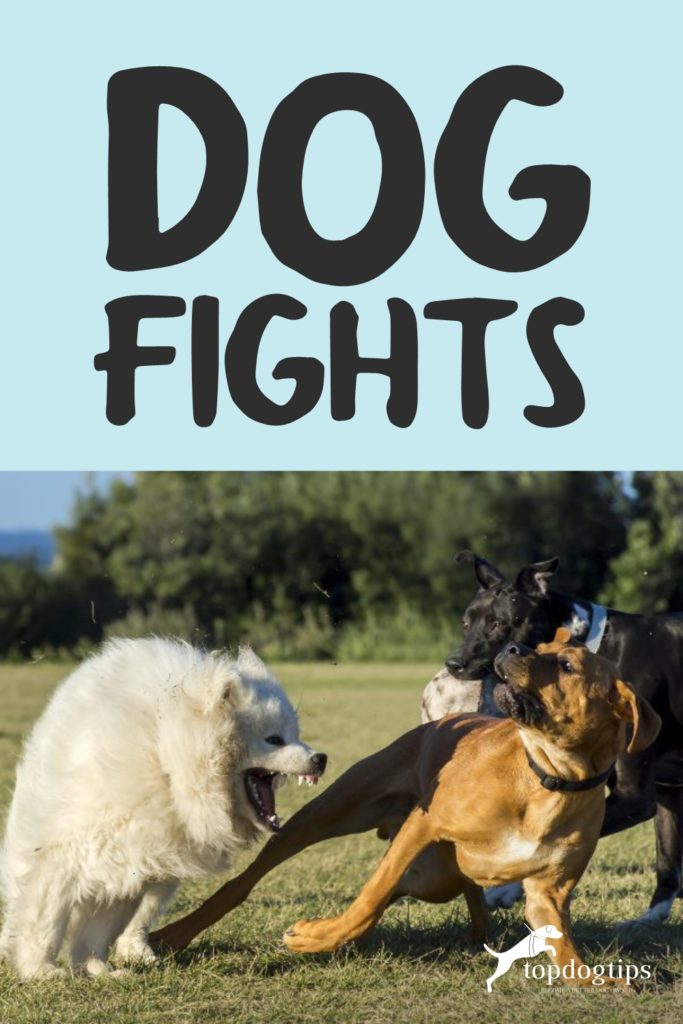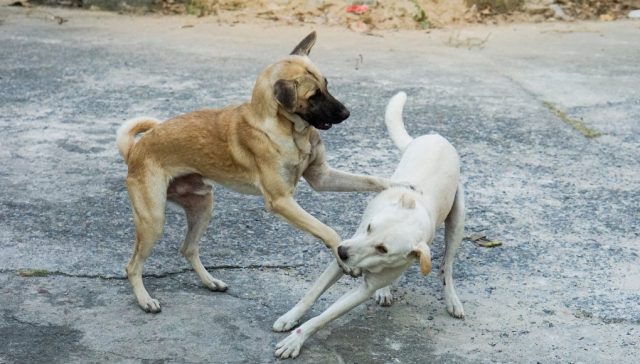
Table of Contents
- Why Do Dogs Fight?
- How To Avoid Fights Between Dogs
- How To Stop A Dog Fight If It’s Too Late?
- After Successfully Stopping A Dog Fight
- FAQs about Dog Fights
- Stopping Dog Fights: Before You Go…
Seeing dogs fight each other can be somehow scary.
Aside from aggressive and brutal dog fights, their fights may lead to severe wounds and injuries or, worse, death.
And not just to them, mind you.
It's also dangerous to the people or other creatures caught in the middle.
These fights are inevitable.
They often happen when dogs are not particularly close to each other. However, it can also be due to territorial issues.
Regardless of whether you're a single-dog household or a multi-pet owner, dog owners must learn how to intervene in the right way safely.
Interested? Below are the easy steps to guide you on how to stop your dogs from fighting.
Read more to continue.

Why Do Dogs Fight?
But before we go straight to the how, let's start with the why.
Why do dogs fight?
Dogs fight because of various reasons, most of which are due to their animal instinct:
1. A dog can start a fight when they're territorial. For example, your dog might fight another dog who trespassed in your yard.
They're likely fighting them because they see the other dog as a threat, and their gut tells them to protect you at all costs.
2. In addition, your dogs will also impulsively fight with other dogs if provoked to steal their food or other prized possessions.
It's normal for dogs to be possessive of things they own.
Thus, if provoked, they will unquestionably fight others to protect it.
3. Dogs can also be aggressive towards other dogs if taunted overly.
If you noticed, many dog interactions started as friendly play that resulted in nasty breakouts.
These fights happen because the other dog might be overly playful or taunting.
On the other hand, dogs tend to fight because they don't get along well.
It may simply be because of their personality differences or other unknown causes.
How To Avoid Fights Between Dogs
Dog fights are inevitable, even if you manage to keep a close eye on your dogs.
However, here are some tips and tricks on how to prevent them from fighting.
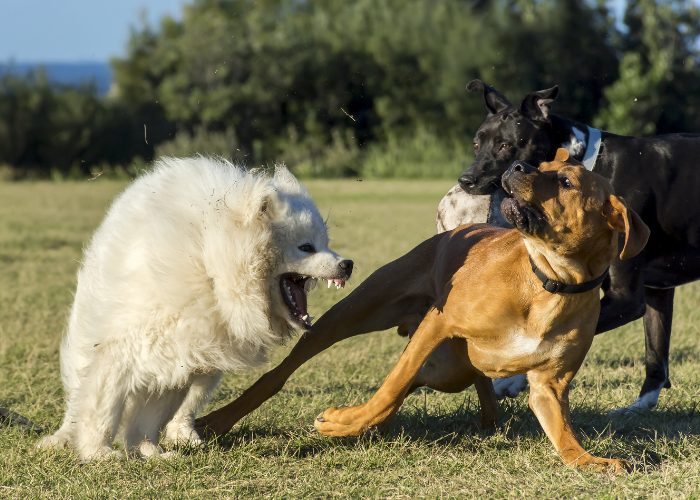
1. When Dogs Meet…
It's a common mistake between pet owners to impulsively collect their pets and expect them to become friends instantly.
However, dogs instinctively fight, especially when they gather together in a big room full of different scents from other dogs. It's their way to know who's their pack leader.
To avoid this, it would be best to let them meet on a neutral territory, where they haven't attempted to mark up yet.
This way, you can help the dogs relax and gradually get along as they try to memorize each other's scent.
Nevertheless, you must be alert at all times. Observe how your dogs interact with other dogs and vice versa.
Always take control of your dogs whenever and wherever you are.
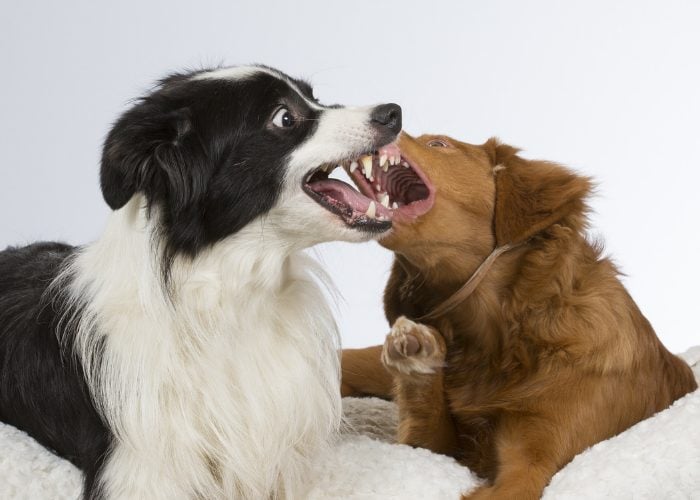
2. Monitor Their Playtime Accordingly
If your canine meets a new dog, it's natural for them to initiate playtime.
When you don't sense any aggression from both pets, let your dogs play along and have fun.
If their playtimes involve wrestling with each other, rest assured that it's normal. They may chase around, roll on the floor, or bite each other using their mouths.
However, it would be best to continually keep an eye on them because if they're left alone, the chances are that they might get overly hyperactive, which may result in unexpected accidents.
Below are some of the red flags that you have to keep in mind:
- If they've been aggressively biting each other numerous times;
- When they start to growl and bark at each other;
- If they are showing the other dog the whale eye (head turned, but the eyes are still looking at the “threat”); and
- When you find their hair and body are still and stiff.
If any disturbing behavior mentioned above happens, pull them immediately away from each other and indicate that playtime is over to avoid rowdy and brutal situations.
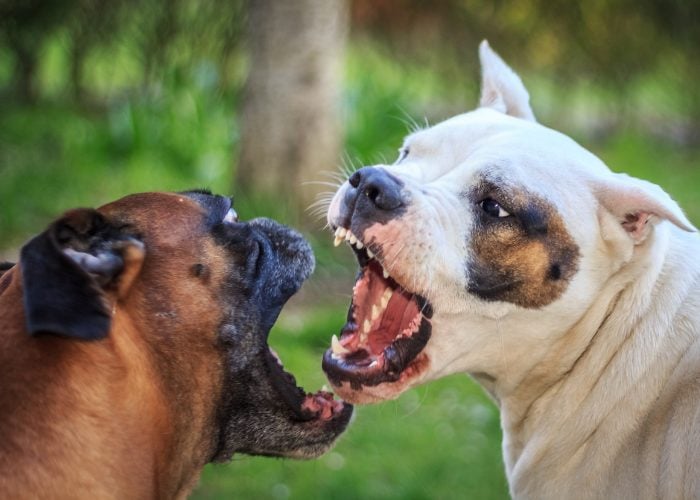
3. Are They Slowly Becoming Aggressive?
If you think your dogs show signs of aggressiveness, proceed to calm them down and help them recognize the other dog.
There are various ways to do it, but you must train them to treat most dogs as harmless.
Furthermore, it would be helpful to teach your dogs that growling at one another is equivalent to bad behavior.
However, it's best not to punish them because they must learn that showing aggressiveness will only give them no rewards.
On the other hand, avoid isolating them from others because the last thing they want once they show signs of aggressiveness is no attention at all.
However, they'll likely be more aggressive and more susceptible to dogs who walk within their vicinity if this happens.
Your dogs may bark, growl, or howl at other dogs to threaten them to stay away as much as possible.
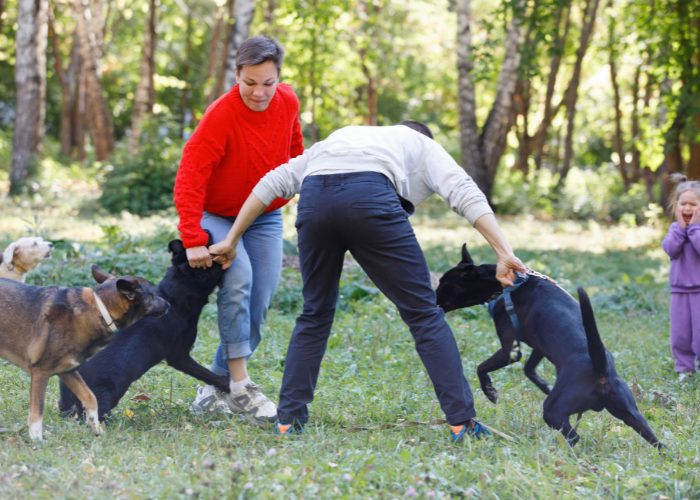
How To Stop A Dog Fight If It’s Too Late?
Admit it; dogs are the cutest pets in the whole wide world—they can be loyal, kind, and caring. In contrast, they become the opposite if filled with anger and aggression.
Hence, dogs are tough to break off once they start to fight because aside from the fact that it's impossible to handle them single-handedly, you might also be risking yourself from possible wounds and injuries.
Below are some tips and tricks to stop your dogs from fighting.
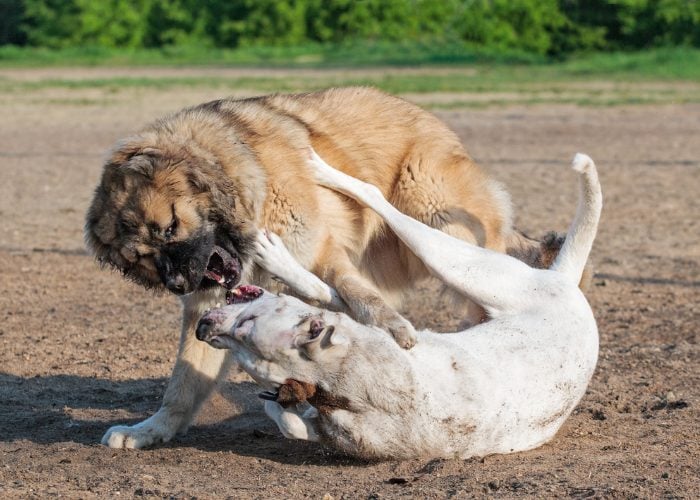
1. Focus on the more aggressive canine
When stopping dogs from fighting, always go for the dog who looks more agitated.
Use touch to redirect their aggression, but use a stick or anything long, thick, and stiff enough for them to snap on.
Never let them touch you at any time; you may suffer from a deep wound bite.
So do not use your arms or legs to redirect that touch.
Proceed on pulling the dogs apart to get them out of the area and away from each other’s noses and peripheral vision.
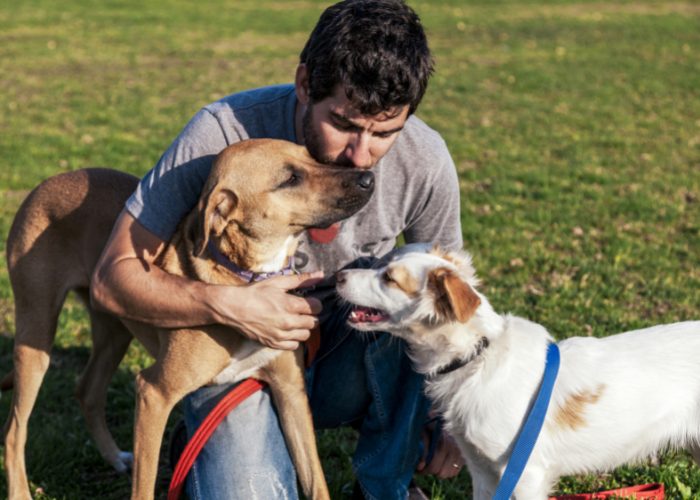
2. Remain calm as you break a dog fight
Do not scream or panic as you pull the two dogs out of each other’s physical presence.
This action may only rile them up and make them more aggressive.
What you need to do as their pack leader is to make a loud shout or grunt to signify your presence and intimidation.
When doing so, always remain calm, especially when attempting to break a dog fight.
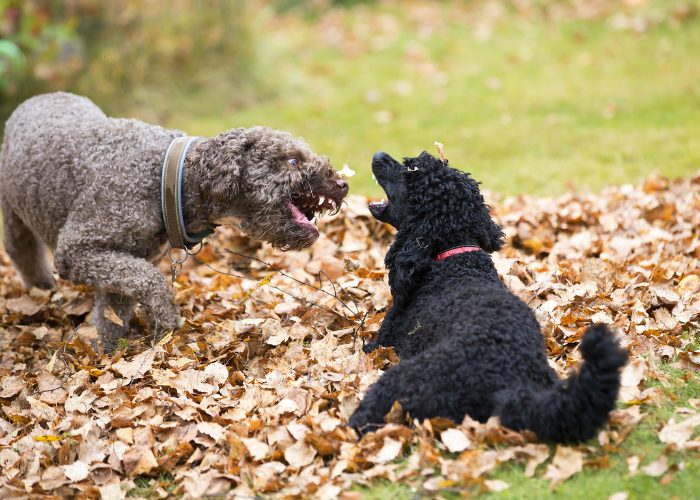
3. Clear the area of anyone that they might harm
If there are people, children, and other pets around, ensure that they stay far from the area before intervening.
It’s always a priority to avoid getting more casualties when a fight breaks out between dogs.
Because if the opposite happens, the whole situation will be more out of control.
It’s best if only the dog owners intervene in the dog fight, as they know their dogs more, among others.
Otherwise, if you’re a passerby, do not attempt to get near to avoid being caught in between.
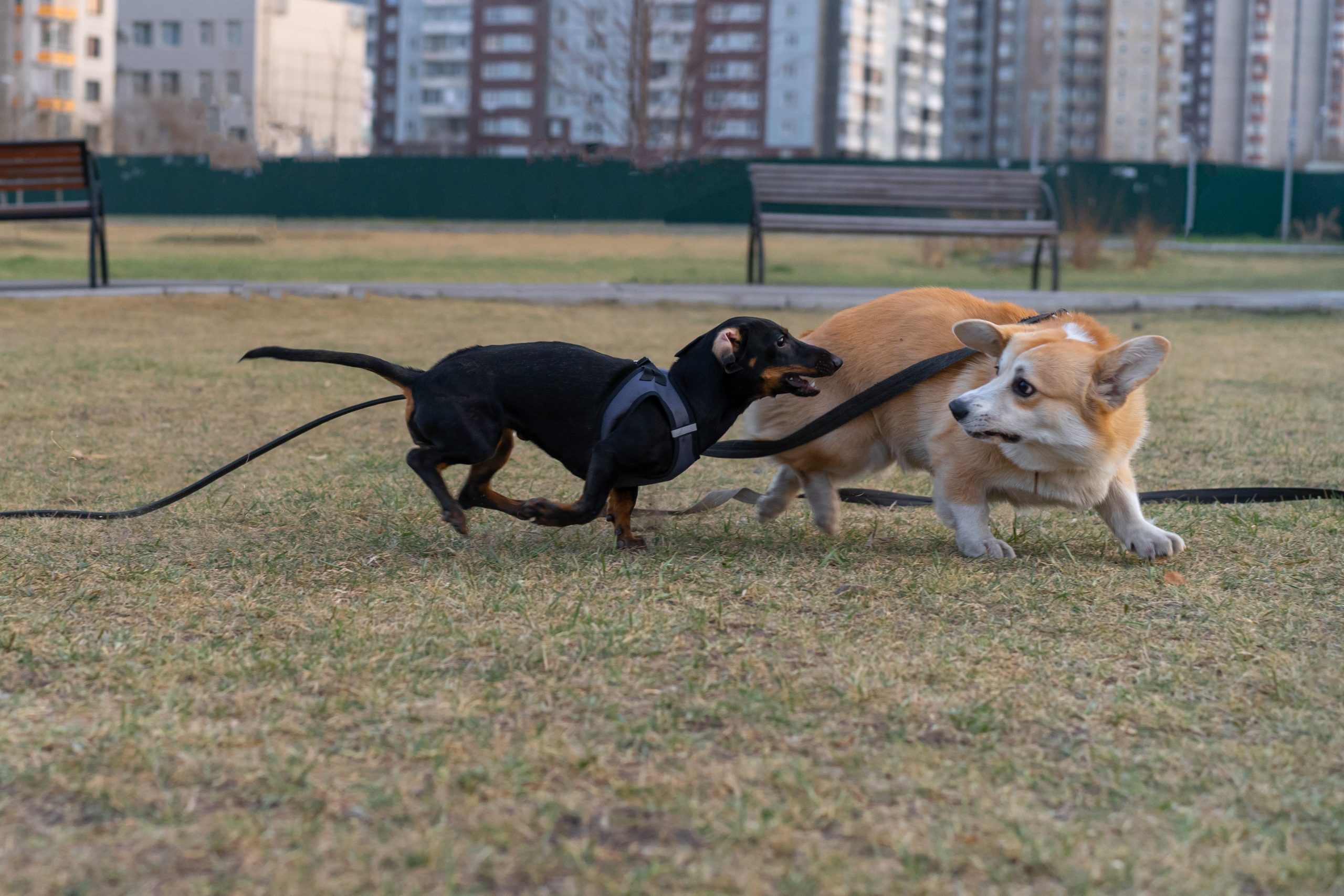
4. Distract them
Another good tip to get them down and stop them from gnawing at each other’s faces is distracting them.
Listed below are three ideas that you may consider in blocking your pets from fighting using distractions.
Spray them down with water or citronella
Water is a good way of distracting anyone because once the water comes in contact during fights, the person affected will reflexively hold their breath to avoid drowning.
The same method applies to animals and can be helpful to stop dog fights.
Dogs hate water, especially if it's mixed with citronella extract; thus, they'll have to stop their fights immediately to get the scent of citronella out of their noses.
Veterinarians generally prefer citronella sprays over pepper sprays as they cause a less severe reaction than the latter.
Hence, you must only resort to it as a last resort, but you must still note the damage it creates on your dog's eyes, nose, and skin.
Create loud noises with anything that you can use
Loud noises effectively break off dog fights because the high-frequency sounds can easily irritate their ears.
Thus, if you have pots and pans nearby, you may bang them together to create some noise, but if you're outdoors, air or car horns are also valuable.
Although this doesn't work for a few dogs, you may consider doing it first to check if it's successful.
Utilize useful objects that you have found nearby.
To stop your dogs from fighting, you may also use other objects, such as blankets, clothing, or pillows.
If there are chairs, baskets, or anything that could block them around, you may use them to take them apart physically.
You may use a technique to distract the fighting dogs by creating a barrier without touching them.
A suggested method is holding a long automatic umbrella, aiming, and opening it between the fighting dogs so they’d stop.
You may use blankets and jackets to obscure the vision of the dogs; this will effectively make them stop for a moment.
While in the middle of getting their visual consciousness back, you can pull them away in a safe space.
These distractions are safe procedures for distracting the dogs and breaking them off from a fight. Use them safely according to your own needs.
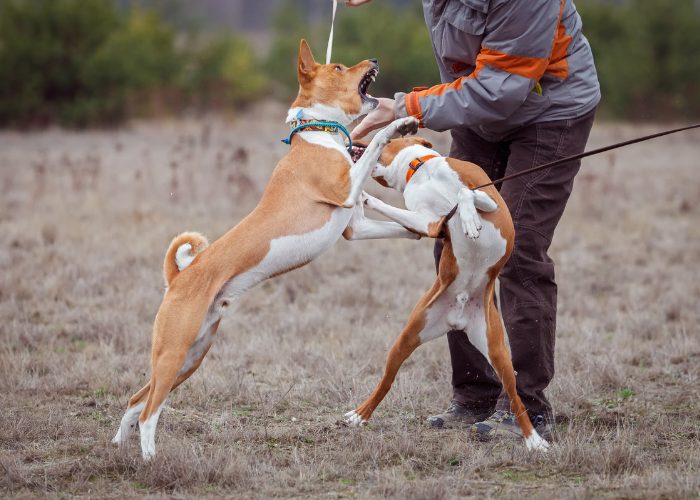
5. Intervene and pull them apart
You may also intervene in the fight by simply holding on to their hind legs while pulling them apart.
This method is called the wheelbarrow method, one of the safest ways to stop a dog fight.
Using this method, one must carefully approach the dogs on both ends and hold their hind legs high enough for them to restrict standing on their front legs.
After getting a hold on their hind legs, slowly walk backward and pull your pet out of the fights.
However, if your dog is on top of one another, you must always pull out the top dog first to avoid inflicting damage on the dog who's at the bottom.
You may also pull on their collar carefully if they have it around their neck. However, you must be cautious when doing this because the dog might strike back and endanger you.
Despite the dangerous scenario you are in, always keep your safety a priority.
Whether you have control or no control over your fighting dogs, always get yourself out of harm's way.
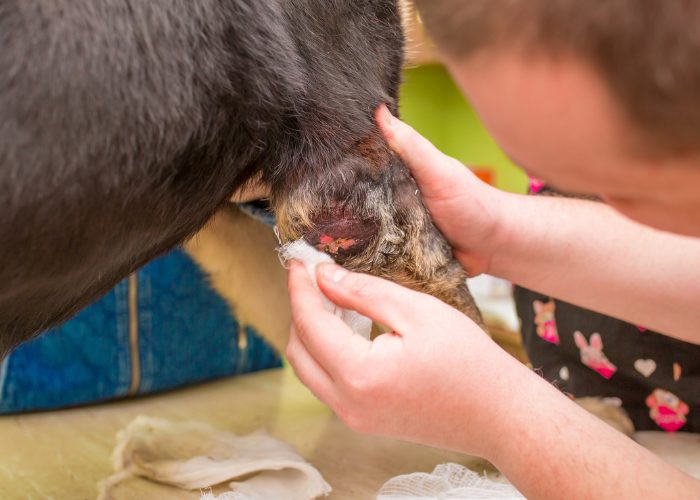
After Successfully Stopping A Dog Fight
After successfully stopping a dog fight, isolate your dog and check for any wounds or injuries immediately.
If they look severe, do not hesitate to go to the nearest vet clinic or hospital to treat them.
However, if it's impossible to take your dog quickly to a medical facility, treat their injuries first by giving them first aid.
If they're suffering from a mild scrape, you need to clean the affected area with warm water and a bar of mild soap before wrapping it with a clean bandage.
However, if your pup is suffering from a deep wound, quickly apply pressure above the wound with a clean towel. This method would at least stop the bleeding.
If they still look fine, get them home to rest, but still monitor them for any changes.
If you notice that they’re showing abnormalities, contact their veterinarian immediately to schedule an appointment.
FAQs about Dog Fights
Do dogs forgive each other after a fight?
Dogs are social animals and naturally tend to seek harmony in their social interactions.
While dogs may fight with each other, they are also capable of forgiving and reconciling with each other after a fight.
In fact, dogs often use body language and vocalizations to communicate their intentions and reconcile after a conflict.
For example, dogs may use play bows, tail wagging, and licking to signal that they want to make up with another dog.
How do you know if a dog fight is serious?
Signs that a dog fight may be serious include the presence of blood, aggressive behavior such as growling or biting, prolonged fighting, the inability to separate the dogs, and fearful behavior such as cowering or hiding.
Do dogs get traumatized after a dog fight?
Yes, dogs can experience trauma after a dog fight, especially if the fight was prolonged, intense, or resulted in injuries.
Trauma can manifest in various ways, including fear, anxiety, aggression, and avoidance behaviors.
Dogs may also become more reactive or sensitive to triggers that remind them of the fight, such as other dogs or certain environments.
It's important to monitor your dog closely after a fight and to seek professional help if you notice any signs of trauma or behavioral changes.
A professional dog trainer or behaviorist can help you develop a plan for managing your dog's behavior and promoting positive social interactions.
Additionally, it's important to provide a safe and secure environment for your dog and to avoid exposing them to situations that may trigger traumatic memories or behaviors.
Stopping Dog Fights: Before You Go…
Dog fights are inevitable because of various reasons. Some of these reasons might involve their natural territorial and possessive characteristics.
Thus, despite being a well-trained canine, you might still expect abrupt bursts of violence and fierceness from your pet.
However, preventing dog fights is better than dealing with injured or wounded dogs. After all, any dispute won't happen if you are there to prevent them in the first place.
In addition, bear in mind that you're your dog's pack leader. If you vigorously enforce that they shouldn't fight, they will behave accordingly.
Furthermore, always help them relieve their feelings of aggression and possessiveness by training them along with other dogs.
Prevention is always better than cure, especially if it involves possible casualties.
Do you want to learn more about dog fights and aggression? Then check out our recommended articles below!
Related Articles:
- How Dog Fighting Business Works
- 4 Safe Ways To Break Up A Dog Fight
- Dog on Dog Attack: How to Safely Break Up a Dog Fight
Want To Share This…


